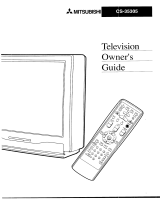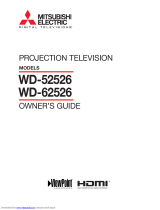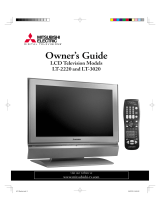Page is loading ...

i_ MITSUBISHI
TV
Owner's
Guide

RISK OF ELECTRIC SHOCK
DO NOT OPEN
CAUTION: TO REDUCE THE RISK OF ELECTRIC SHOCK,
DO NOT REMOVE COVER (OR BACK).
NO USER-SERVICEABLE PARTS INSIDE.
REFER SERVICING TO QUALIFIED SERVICE PERSONNEL.
The lightning flash with arrowhead symbol,
within an equilateral triangle, is intended to alert
the user to the presence of _minsulated "danger-
ous voltage" within the product's enclosure that
may be of sufficient magnitude to constitute a
risk of electric shock.
The exclamation point within an equilateral
triangle is intended to alert the user to the
presence of important operating and maintenance
(servicing) instructions in the literature accompa-
hying the appliance.
WARNING:
TO PREVENT FIRE OR SHOCK HAZARD, DO NOT EXPOSE THIS APPLIANCE TO I_kIN OR
MOISTURE.
CAUTION:
TO PREVENT ELECTRIC SHOCK HAZARD, DO NOT USE THIS (POLARIZED) PLUG WITH
AN EXTENSION CORD, RECEPTACLE OR OTHER OUTLET UNLESS THE BLADES CAN BE
FULLY INSERTED TO PREVENT BLADE EXPOSURE.
NOTE TO CATV SYSTEM INSTALLER:
THIS REMINDER IS PROVIDED TO CALL THE CATV SYSTEM INSTALLER'S ATTENTION
TO ARTICLE 820-40 OF THE NEC THAT PROVIDES GUIDELINES FOR PROPER GROUND-
ING AND, IN PARTICULAR, SPECIFIES THAT THE CABLE GROUND SHALL BE COIN-
NECTED TO THE GROUNDING SYSTEM OF THE BUILDING, AS CLOSE TO THE POINT OF
CABLE ENTRY AS PRACTICAL.

MITSUBISHI OWNER'S GUIDE
Table of Contents
Important Safeguards ............................................................................................................................ 3
Preface: Welcome to Mitsubishi ..... .................................................................................................... 9
Summary of Special Features ........................................................................................................ 10
Unpacking Your TV .......................................................................................................................... 11
What you'll find .......................................................................................................................... 11
A few suggestions ..................................................................................................................... 11
What's in Each Chapter .................................................................................................................. 12
Some Conventions Used in this Guide .......................................................................................... 13
Chapter 1: Getting to Know Your TV ............................................................................................... 15
Overview of the Control Panel ....................................................................................................... 16
Overview of the Remote Control .................................................................................................... 19
Getting ready to use the remote control .................................................................................. 19
Remote control buttons and functions ...................................................................................... 21
Chapter 2: Connecting Your TV ......................................................................................................... 25
Overview of the Back Panel ........................................................................................................... 26
Basic Connections .......................................................................................................................... 28
TV+external speakers ................................................................................................................ 29
TV+antenna or cable without a decoder box ............................................................................ 30
TV+cable with a decoder box .................................................................................................... 31
TV+separate UHF and VHF antennas ...................................................................................... 33
TV+VCR+antenna or cable without a decoder box .................................................................... 34
TV+VCR+cable with a decoder box ........................................................................................... 37
TV+home theater receiver (A/V receiver) ................................................................................ 40
TV+audio system ...................................................................................................................... 42
TV+Mitsubishi products that have A/V Network terminals ................................................... 43
Chapter 3: Operating Your TV ........................................................................................................... 45
Getting Started .............................................................................................................................. 46
Adjusting the color purity ........................................................... :............................................. 47
Using the remote control ........................................................................................................... 48
Table of Contents 1

Getting Started (cont.)
Turning the TV on/off ................................................................................................................ 52
Selecting the input source ........................................................................................................ 53
Changing channels ..................................................................................................................... 54
Understanding the on-screen menus ........................................................................................ 57
Setting the clock ........................................................................................................................ 58
Memorizing channels ................................................................................................................. 60
Adding and deleting channels ................................................................................................... 61
Setting the A/V Network ............................................................................................................ 62
Renaming the inputs ................................................................................................................. 63
Selecting the on-screen language ............................................................................................... 64
Using video mute ........................................................................................................................ 65
Using the power restore feature .............................................................................................. 66
Using the advanced PIP functions ........................................................................................... 67
Adjusting the sound .................................................................................................................. 68
Adjusting the picture ................................................................................................................. 70
Using the closed caption decoder ............................................................................................. 72
Using the Advanced Features ........................................................................................................ 73
Setting the timer ....................................................................................................................... 74
Using the parental lock .............................................................................................................. 75
Using the Super Quick View tuning ......................................................................................... 77
Chapter 4: Using the Special Features
Understanding the On-Screen Displays ......................................................................................... 80
Using the Off-Timer ......................................................................................................................... 81
Setting the off-timer .................................................................................................................. 82
Changing or canceling the off-timer ......................................................................................... 83
Using the Picture-in-Picture (PIP) Mode ....................................................................................... 84
Selecting the PIP image ............................................................................................................ 85
Selecting the source .................................................................................................................... 86
Selecting the channel ................................................................................................................ 86
Exchanging the PIP image ......................................................................................................... 87
Moving the PIP image ............................................................................................................... 87
Freezing the PIP image ............................................................................................................... 88
Using the Snap-shot feature ........................................................................................................ 89
Using the Replay feature ............................................................................................................ 90
Using the Active A/V Network Feature .......................................................................................... 91
Chapter 5: Troubleshooting ............................................................................................................... 95
Caution and Care ............................................................................................................................ 98
Calling for Service ........................................................................................................................... 99
Appendix: Automatic Procedure for the Parental Lock ............................................................. 100
Index ................................................................................................................................................... 101
Warranty ........................................................................................................................ Inside back cover
2 Table of Contents

IMPORTANT SAFEGUARDS
PLEASE READ ALL THESE INSTRUCTIONS REGARD-
ING YOUR TELEVISION SET AND RETAIN FOR FU-
TURE REFERENCES. FOLLOW ALL WARNINGS AND
INSTRUCTIONS MARKED ON THE TV :RECEIVER.
. Read Instructions
All the safety and operating instructions should be read
before the appliance is operated.
. Retain Instructions
The safety and operating instructions should be retained for
future reference.
.
Heed Warnings
All warnings on the appliance and in the operating instruc-
tions should be adhered to.
. Follow Instructions
All operating and use instructions should be followed.
°
Cleaning
Unplug this TV receiver from the wall outlet before cleaning.
Do not use liquid or aerosol cleaners. Use a damp cloth for
cleaning.
.
Attachment and Equipment
Never add any attachments and/or equipment without
approval of the manufacturer as such additions may :result in
the risk of fire, electric shock or other personal injury.
. Water and Moisture
Do not use this TV receiver where contact with or immersion
in water is a possibility. Do not use near: bath tubs, wash
bowls, kitchen sinks, laundry tubs, or swimming pools, etc.
l_Warning:
Don't leave stationary images, such as those generated from
stock market reports or video games, on-screen for more than
10 minutes. Still patterns can scar the TV causing permanent
damage to the picture tube.
3

° Accessories
Do not place this TV receiver on an un,_table cart, stand,
tripod, bracket, or table. The TV receiver :may fall, causing
serious injury to a child or adult, and serious damage to the
appliance. Use only with a cart, stand, tripod bracket, or
table recommended by the manufacturer, or sold with the TV
receiver. Any mounting of the appliance should follow the
manufacturer's instructions, and should use a mounting
accessory recommended by the manufacturer.
An appliance and cart combination should be moved with
care. Quick stops, excessive force, and uneven surfaces may
cause the appliance and cart combination to overtu_m.
.
S 3126 A
Ventilation
Slots and openings in the cabinet are provided for ventilation
and to ensure reliable operation of the TV receiver and to
protect it from overheating. Do not block these openings or
allow them to be blocked by placing the TV receive:c on a bed,
sofa, rug, or other similar surface, nor should it be placed
over a radiator or heat register. If the TV receiver is to be
placed in a rack or bookcase, ensure that there is adequate
ventilation and that the mmmfacturer's instructions have
been adhered to.

10.
11.
12.
13.
14.
PowerSources
ThisTVreceivershouldbeoperatedonlyfromthetypeof
powersourceindicatedonthemarkinglabel.If youarenot
sureofthetypeofpowersupplytoyourhome,consultyour
appliancedealerorlocalpowercompany.
GroundingorPolarization
Foryoursafety,thisTVreceiverisequippedwithapolarized
alternatingcurrentlineplughavingonebladewiderthan
theother.Thisplugwill fit intothepowderoutletonlyone
way.If youareunabletoinserttheplugfullyintotheoutlet,
try reversingtheplug.If theplugshouldstill fail tofit,
contactyourelectriciantoreplaceyourobsoleteoutlel;.Do
notdefeatthesafetypurposeofpolarizedplug.
Power-CordProtection
Power-supplycordsshouldberoutedsol_hattheyarenot
likelytobewalkedonorpinchedbyitemsplaceduponor
againstthem,payingparticularattentiontocordsatplugs,
conveniencereceptacles,andthepointwheretheyexitfrom
theappliance.
Lightning
Foraddedprotectionforthis[IV receiverduringalightning
storm,orwhenit isleftunattendedandunusedforlong
periodsoftime,unplugit fromthewalloutletanddisconnect
theantennaorcablesystem.Thiswill preventdamagetothe
videoproductduetolightningandpower-linesurges.
PowerLines
Anoutsideantennasystemshouldnotbelocatedinthe
vicinityofoverheadpowerlinesorotherelectriclight or
powercircuits,orwhereit canfall into suchpowerlinesor
circuits.Wheninstallinganoutsideantennasystem,extreme
careshouldbetakentokeept_omtouchingsuchpowerlines
orcircuitsascontactwiththemmightbefatal.

15.
16.
17.
Overloading
Donotoverloadwalloutletandextensioncordsasthiscan
resultin ariskoffireorelectricshock.
ObjectandLiquidEntry
NeverpushobjectsofanykindintothisTVreceiverthrough
openingsastheymaytouchdangerousvoltagepointsor
short-outpartsthatcouldresultin afire orelectricshock.
NeverspillliquidofanykindontheTVreceiver.
OutdoorAntennaGrounding
If anoutsideantennaorcablesystem:isconnectedtotheTV
receiver,besuretheantennaorcablesystemisl_oundedso
astoprovidesomeprotectionagainstvoltagesurgesand
built-upstaticcharges.
Section810oftheNationalElectricalCode,ANSUNFPA
No.70-1984,providesinformationwithrespecttoproper
groundingofthemastandsupportiagstructure,grounding
ofthelead-inwiretoanantennadischargeunit,sizeof
groundingconductors,locationofantenna-dischargeunit,
connectiontogroundingelectrodes,andrequirementsforthe
groundingelectrode.
EXAMPLEOFANTENNAGROUNDING
ASPERNATIONALELECTRICALCODE
ENNA
LEAD IN WIRE
NEC --NATIONAL ELECTRICAL ('ODE
DISCHARGE IJNIT
(NEC SECTION 810---20)
GROUNDING
CONDUCTORS
(NECSECTION810--21)
GROUND CLAMPS
POWER SERVICE GROUNDING
ELECTRODE SYSTEM
(NI-C ART 250, PART H)

18.
19.
20.
21.
Servicing
Do not attempt to service this TV receiw'.r :yourself as open-
ing or removing covers may expose you to dangerous voltage
or other hazards. Refer all servicing to qualified service
personnel.
Damage Requiring Service
Unplug this TV receiver from the wall outlet and refer
servicing to qualified service personnel under the following
conditions:
(a) When the power-supply cord or plug is damaged.
(b) If liquid has been spilled, or objects have fallen into the
TV receiver.
(c) If the TV receiver has been exposed to rain or water.
(d) If the TV receiver does not operate normally by following
the operating instructions. Adjust only those controls that
are covered by the operating instructions as an improper
adjustment of other controls may result in damage and will
often require extensive work by a qualified technician to
restore the TV receiver to :its normal operation.
(e) If the TV receiver has been dropped or the cabinet has
been damaged.
(f) When the TV receiver exhibits a distinct change in perfor-
mance - this indicates a need for service.
Replacement Parts
When replacement parts are required, be sure the se_ice
technician has used replacement parts specified by the
manufacturer or have the same characteristics as the origi-
nal part. Unauthorized substitutions may result in fire,
electric shock or other hazards.
Safety Check
Upon completion of any service or repairs to this TV receiver
ask the service technician to perform safety checks to deter-
mine that the TV receiver is in a safe operating condition.
3


PREFACE
Welcome to Mitsubishi
Congratulations on your purchase of your new CS-40505
Mitsubishi TV. Your TV is designed tbr superb viewing pleasure
as well as continued reliability.
To familiarize you with your TV and owner's _ide, we suggest
that you read through the preface, which provides the following
important information:
• Summary of Special Features
• Unpacking Your TV
• Whatts in Each Chapter
• Some Conventions Used in Thi:_ Guide
Mitsubishi has strived to create your TV so that it will bring you
years of viewing enjoyment. Similarly, your owner's guide is de-
signed with a "user friendly" philosophy that will help you take
advantage of all of your equipment's features.
Once again, thank you for selecting our product and welcome to
Mitsubishi!

* Summary of Special Features
Your top rated Mitsubishi TV delivers:
• 181-Channel Capacity --- programs up to 181 channels,
ensuring your continued viewing pleasure as cable semrices
continue to expand.
• Two-Speaker Sound System --- a special speaker system
that produces clear stereo sound.
• Expanded Sound Capability --- allows you to connect the TV
to an external audio system for enhanced listening pleasure.
In addition to the standard features found on most advanced TVs,
Mitsubishi is proud to offer the following distinctive features:
Remote Control with TV/VCPJCABLE Function --- uses a
single remote control transmitter for the television, certain
Mitsubishi VCRs, and also some VCRs and cable boxes of other
manufacturers.
• On-Screen Displays --- appear whenew_r you adjust your TV,
showing you the status of your TV's va:cious functions
• On-Screen Menu --- simplifies the television's features with
easy to follow instructions.
• Closed Caption Decoder --- supplies you the text information
along with the regular broadcasts.
Extended Data Services --- (also known as "XDS,") allows
broadcasters to supply you with the time of day, channel infor-
mation, and program information. You. can display this infor-
mation on-screen.
• Picture-in-Picture Mode --- allows you to view two different
sources at the same time.
• Active AN Network --- allows you to perform many of the
commonly used features of your system at the press of just one
button.
Each of these features will be explained in more detail in Chapter
3, "Operating Your TV," and Chapter 4, "Using the Special Fea-
tures."
10 Preface

Unpacking Your TV
What you will find
As you unpack your new TV, please check to be sure that along with
the TV, the following items are included:
• an owner's guide that includes a warranty:.
• a registration card,
• a remote control transmitter,
• a set of two AA size batteries for the remote ,control,
• 2 sets of speaker leads, and
• an A/V network cable.
A few suggestions
Before you hook up your new TV, please take a few minutes to:
O Complete the registration card. The registration card asks for
the TV's serial number, which you'll find on the back of the unit.
O Keep the box and packing materials for future use.
File your sales receipt.
O :Place the TV on a stable surface with sufficient lighting to do
the hook-up.
Unpacking Your TV 11

• What's in Each Chapter
Here's what you will find in this owner's guide:
Chapter 1, "Getting to Know Your TV," introduces you to the
location and functions of the buttons and controls of your _.
Chapter 2, "Connecting Your TV," explains how to connect a VCR,
antenna, cable decoder, and other equipment to your TV.
Chapter 3, "Operating Your TV," provides the step-by-step instruc-
tions you need in order to use your TV.
Chapter 4, "Using the Special Features," explains how to use some
of the special features of the TV.
Chapter 5, "Troubleshooting," summarizes the problems you may
have along with the suggestions for solving these problems.
The appendix explains an automatic procedure for the parental
lock.
You'll also find a detailed index at the back of the book.
12 Preface

. Some Conventions Used in this Guide
Mitsubishi has gone to great effort to provide users with an easy-to-
follow, useful owner's guide. Different types of information are treated
in different ways.
Users should read information labeled Important and information
that is boxed and labeled Warning. The owner's guide uses these
terms sparingly, and all information highlighted in this manner
should be read carefully.
related topic or task I main topic or task J
I O, _, etc. I FbWarn_ing
Procedures, the step-by-step
instructions on how to accom-
plish a particular task, are
signaled by white numbers set
in a black background.
This cue indicates
information critical
to the operation of
your new TV.
This cue alerts you to
information describing
dangerous situations
which could ruin your
equipment or cause
electrical shock.
Some Conventions Used in this Guide 13


CHAPTER 1
Get- ng to Know Your TV
Now that you've unpacked your TV, read through the safety infor-
mation, and glanced at the overview explaining how this owner's
guide is organized, it's time to become familiar with the bu'Ltons
and controls you'll be using when you operate the TV. This chapter
will introduce the range of options available by using the buttons
on tile control panel of the TV or the remote control. It also offers
some general guidelines for using the remote control.
Most functions can be controlled by using either the control panel
or the remote control, but certain specialized J_unctions require you
use to one or the other. This chapter, which will familiarize you
with the full range of button functions, contains the following
sections:
• Overview of the Control. Panel
• Overview of the Remote Control

Overview of the Control Panel
Push to open the control panel.
control panel
T
0 PnOG_M
TIMER
L (l__
front AV terminal
color purity adjustment switches
Set to the suitable position.
(_) power button (POWER)
Use to turn the TV on or off.
@ A/V reset button (AN RESET)
Press to reset all audio and video functions to their normal level
or setting, except for volume, reception mode (Stereo/SAP/
Mono), speaker (internal/external), monitor out (variable/fixed)
and closed captioning.
16 Chapter 1 : Getting to Know Your TV

(_) volume controls
(VOL)
Press the • button to turn up the volume and the • button to
turn down the volume.
(_) channel controls (CHANNEL)
Use the • button to switch to a channel with a higher number
and the • button to switch to a channel with a lower number.
(_) input buttons (INPUT)
Use either button to select the input source to be viewed:
• Antenna A,
• Antenna B, or
• External 1, 2, or 3.
©audio and video controls
These buttons are used in pairs to adjust features of the image
or sound (other than volume)with a two-step process: using one
of the audio or video buttons to select a function, and then using
an adjust button.
audio function buttons (AUDIO)---Use to select one of the
following audio functions:
-stereo/SAP/mono,
-bass,
-treble,
-balance,
-audio expansion,
-level sound on/off,
-speaker internal/external, or
-monitor out variable/fixed.
video function buttons (VIDEO)---Use to select one of the
following video functions:
-tint,
-color,
-contrast,
-brightness,
-sharpness,
-video noise reduction on/off,
-color temperature low/middle/high,
-color bias average/accurate/skin-tone, or
-closed captioning.
adjust buttons (ADJUST)---After selecting the audio or video
function, use either the up or the down button to adjust the
function you've selected. These buttons can be used to:
-turn the function on or off (e.g., video noise reduction),
-increase or decrease the function (e.g., color),
-shift from one end of a scale to the other (e.g, balance), or
-select a position (e.g., stereo).
The adjust buttons are also used to select an item from the
on-screen menu.
Overview of the Control Panel 17

Overview of the control panel (cont.)
(_ degauss button (DEGAUSS)
Use this button to correct color impurity.
program timer indicator (PROGRAM TIMER)
Lights up when the TV is prograramed to turn on at a particular
time.
(_) s-video input terminal
Use to connect the video output of a Super VHS (S-VHS) VCR to
tile TV. If you connect a S-VHS VCR to this terminal, EXT-3 will
automatically be the input fi)r viewing the S-VHS VCR.
video input terminal
Use to connect the video output from a standard VCR o1"another
component to the TV.
audio input terminals
Use to connect the audio from a VCR or other equipment.
18 Chapter 1 : Getting to Know Your TV
/




